Lake Mead sports a surface area of 247 square miles, and its magnificent shoreline measures 759 miles. This lake extends more than 110 miles upstream from Hoover Dam to the head of the Grand Canyon. It supports diverse recreational activities like fishing, boating, camping, and swimming, but how deep is Lake Mead?
What Is The Depth And Maximum Capacity Of Lake Mead?
How big is Lake Mead? Lake Mead has a maximum depth of more than 532 feet. This massive reservoir is the largest in the U.S., having a capacity of 28,945,000 acre-feet. The reservoir was part of the original construction of the Hoover Dam on the Colorado River between Nevada and Arizona. So, when dam construction was over in 1936, Lake Mead began to fill soon after.
Since its creation, Lake Mead has been an important water source for the Southwest. The reservoir stores water released from Hoover Dam and distributes it to municipal and agricultural users in Arizona, California, and Nevada. In addition, Lake Mead helps regulate the flow of the Colorado River and supports several endangered species.
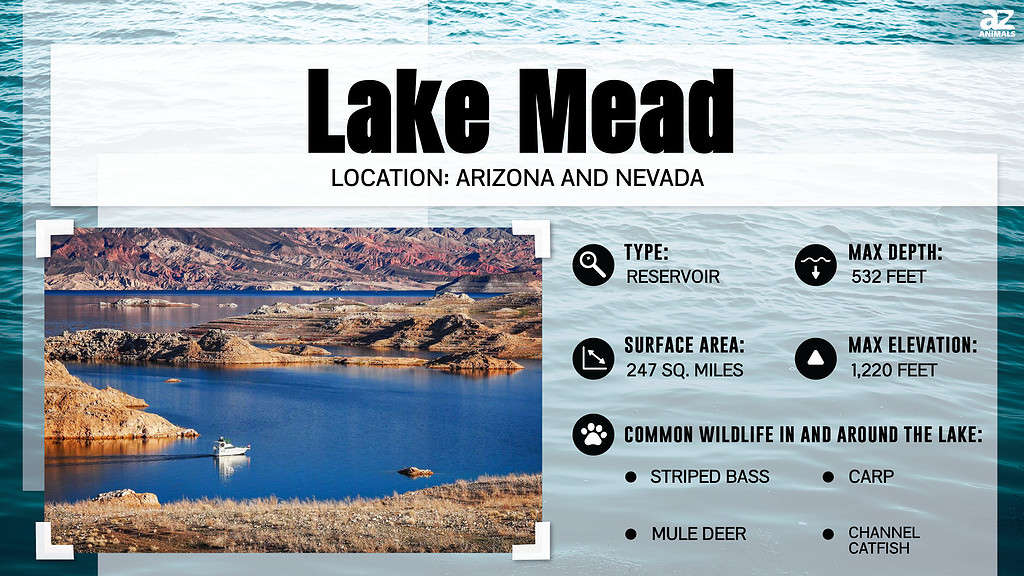
Where Is Lake Mead?
Lake Mead is located on the border between Arizona and Nevada. It is the largest reservoir in the United States, formed by water from the Colorado River. The lake was named after Elwood Mead, a former commissioner of Reclamation for the U.S. Bureau of Reclamation (USBR). The area around Lake Mead is part of the Lake Mead National Recreation Area and provides many recreational activities such as boating, fishing, swimming, and hiking. There are also several campgrounds located near Lake Mead which provide visitors with access to all these amenities.
Which Rivers And Tributaries Feed Lake Mead?
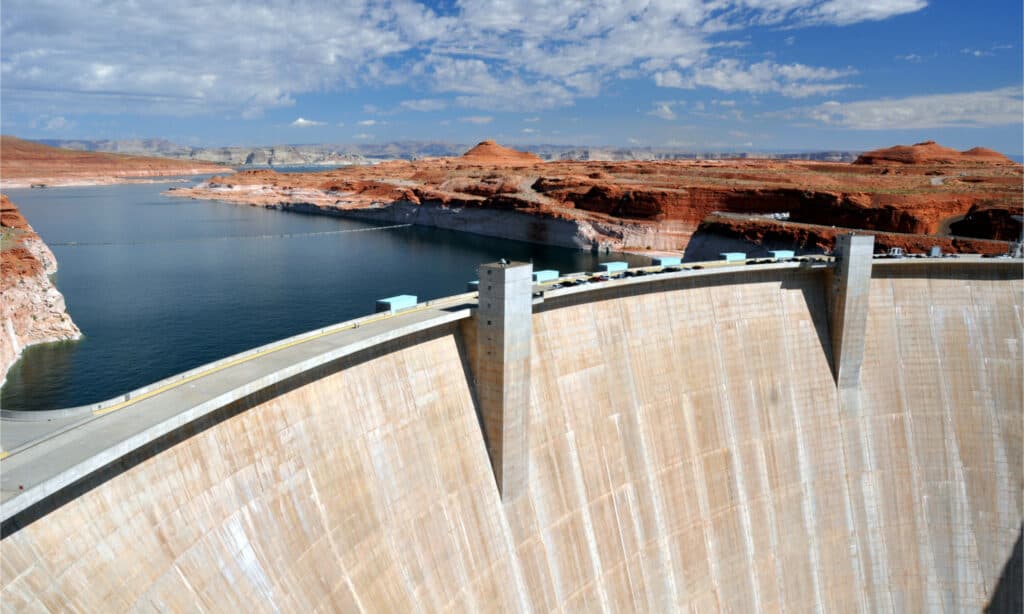
Lake Mead is more than 532 feet deep and has a maximum capacity of 28,945,000 acre-feet.
©Matej Hudovernik/Shutterstock.com
The Colorado River feeds Lake Mead together with three smaller tributaries: the Virgin River, the Muddy River, and the Paria River. And the Colorado River is one of North America’s longest rivers, starting its 1,450-mile journey in the Rocky Mountains and ending in the Gulf of California. Moreover, the Virgin River is the longest of Lake Mead’s tributaries, running 225 miles from Utah to Nevada. Besides, the Muddy and Paria rivers are about 100 miles long.
What Is Lake Mead’s Water Used For?
Lake Mead’s water is a vital resource for the Southwest. About 75% of the water goes to irrigation for agriculture, supplying around 60% of the food for the nation. Nearly 40% of Arizona‘s water supply comes from Lake Mead. The water also helps to power several hydroelectric dams that produce a portion of the Southwest’s electricity.
Is Lake Mead In Danger Of Drying Up?
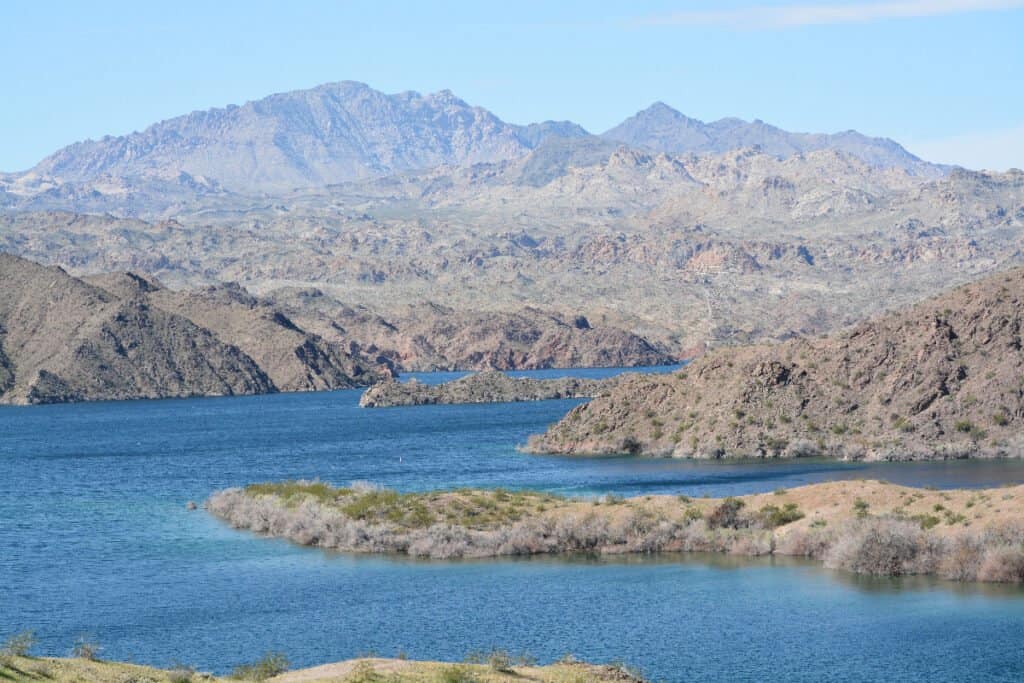
Although Lake Mead reached its capacity in 1983, it has since declined
©Norm Lane/Shutterstock.com
Lake Mead’s water levels have been fluctuating quite a bit lately. Lake Mead’s depth hit its lowest point in 2007 and has been on the rise since then, but it is still well below its capacity. In fact, as of the fall months of 2017, the lake was at about 40% capacity with about ten million-acre feet of held water.
Lake Mead and the second largest U.S. reservoir, Lake Powell, compete for capacity bragging rights. However, as of 2013, Lake Powell is actually in the lead. Lake Mead reached its peak capacity in 1983 but has declined since then.
The main driver behind this decline is the decreasing snowpack in the mountains that feed the two lakes. The Colorado River basin has been experiencing a drought for 16 years now, and it does not seem that it will let up anytime soon.
What Problems Are Caused By Lake Mead’s Decreasing Water Levels?

The water supply to Lake Mead via its river sources has been drying up for years.
©Public Domain – License
Lake Mead is in big trouble. The reservoir’s water level has dropped so much that it is now half empty. Scientists predict that it will probably never fill up to capacity again. This situation is a significant problem for the more than 22 million people who rely on the reservoir for their water supply. The water levels are also affecting the Southwest’s environment, which is closely tied to the fate of the Colorado River.
There are many reasons for Lake Mead’s decreasing water levels. The main one is climate change, which causes less rain and snowfall in the area. The other factors include the ever-growing population of the Southwest and the subsequent increasing demand for more water.
But, there are some things authorities can do to solve this problem. One is to reduce the amount of water that they use. Another is to find new ways to store and use water. So, there is now an initiative known as the Fill Lake Mead First Proposal, which aims to improve the water situations for Lake Mead. However, if things do not start to improve soon, there could be some major issues in the coming years.
Why Is Lake Mead So Popular?
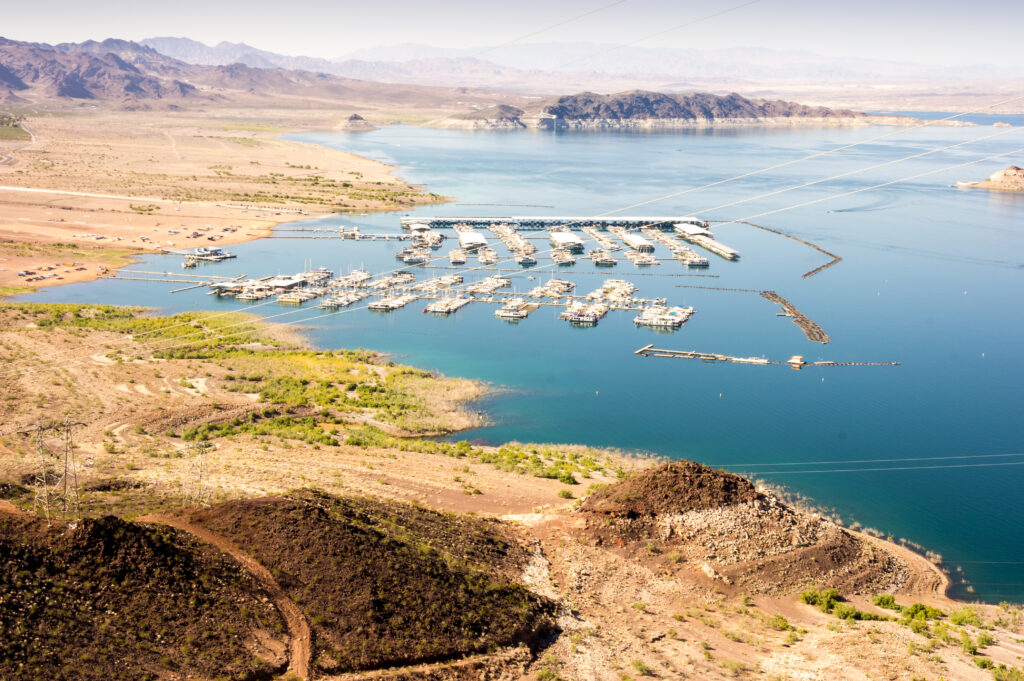
Hemenway harbor is in Nevada at Lake Mead.
©Sopotnicki/Shutterstock.com
Lake Mead is among the most popular tourist destinations in the U.S. The vast body of water is a popular spot for boating and water sports, kayaking, canoeing, swimming, sunbathing, and some of the nation’s best sport fishing.
This lake is also a great place to relax and take in the area’s natural beauty. Situated near Las Vegas, Lake Mead is a convenient destination for visitors to the city. It is also close to other popular tourist destinations, such as the Grand Canyon and Zion National Park, making it a sought-after vacation destination.
Where Is Lake Mead Located On A Map?
Lake Mead is located in the Black Canyon approximately 30 miles east of Las Vegas in the Mojave Desert, on the Colorado River, about 40 minutes east of Las Vegas, Nevada. The lake is also located near Moapa and the Grand Canyon.
Lake Mead Recreation
Lake Mead is a great place to spend time because it has many different types of recreation to travelers and locals alike. Some of these recreational activities include boating, fishing, swimming, sunbathing, and even water skiing. There are four marinas located on Lake Mead which are Vegas Boat Harbor and Lake Mead Marina. The area has many edgy rocks and cliffs.
Several small to medium-sized islands have been known to emerge depending on water levels. Additionally, the Alan Bible Visitor Center often hosts a Garden Club and there is also another recreational center called Grand Wash.
Additionally, The Desert Princess operated by Lake Mead Cruises is a paddle-wheeler to carry about 275 passengers. It travels through the Hoover Dam five times a week.
Wildlife
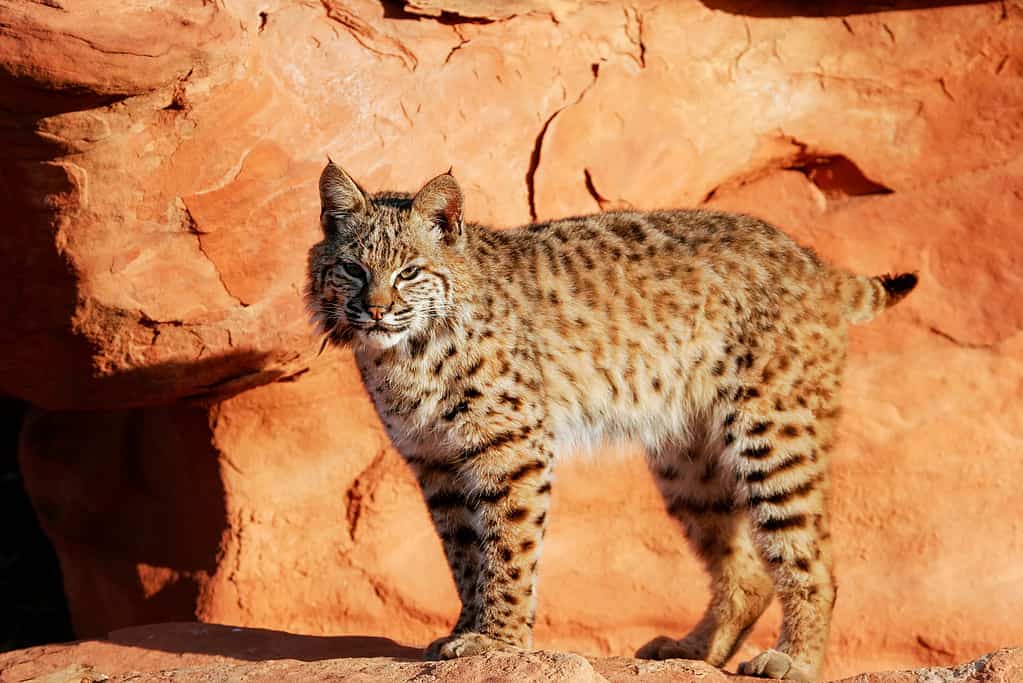
Bobcat
(Lynx rufus) standing on red rocks.
©Don Mammoser/Shutterstock.com
Lake Mead National Recreation Area is home to a variety of wildlife, both inside and outside the lake. In addition to birds such as herons, grebes, and ducks, mammals like coyotes and bobcats can be found living around the area. Reptiles including lizards and snakes often roam the shoreline hunting for small prey or basking in the sun. Fish are abundant in Lake Mead with more than 20 species ranging from bass to catfish that call it home.
These animals play an important role in maintaining a balanced ecosystem by keeping populations of other organisms in check. For example, fish feed on insects living near the surface which helps reduce insect numbers. Predators like coyotes keep small mammal populations under control so they don’t overpopulate an area. By providing food sources for larger animals like birds of prey, these creatures also help ensure their presence at Lake Mead National Recreation Area remains strong throughout all seasons, thus enabling natural processes essential for healthy ecosystems to continue uninterruptedly.
What’s So Special About The Lake Mead Eco-System?
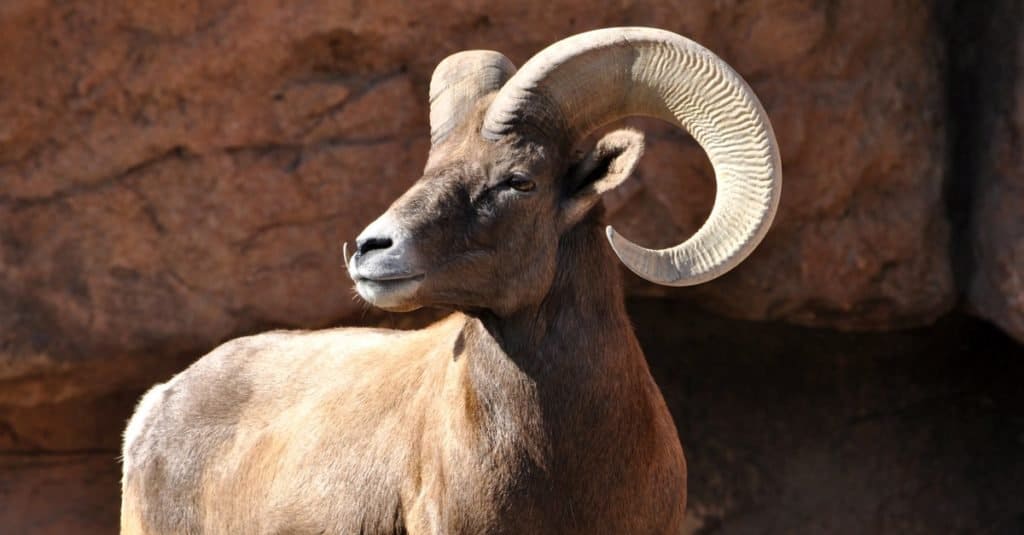
Bighorn sheep live close to Lake Mead
©Georgia Evans/Shutterstock.com
Lake Mead National Recreation Area is the home of assorted plants and animals that grow nowhere else in the world. This indigenous characteristic is due to the area’s location at the junction of three of the nation’s four desert ecosystems: Mojave, Great Basin, and Sonoran deserts. This spot also means that the area is home to many plants and animals uniquely adapted to the desert climate.
Some of the most notable plant and animal species near Lake Mead include the Joshua tree, bighorn sheep, burros, and hummingbirds. The Joshua tree is a unique spectacle in the Mojave Desert, where it is also an indigenous plant. Additionally, bighorn sheep only inhabit the Rocky Mountains and western states. Burros were introduced to the area in the 1930s and have since become a staple of the local wildlife. Finally, hummingbirds are common throughout the Southwest but particularly abundant near Lake Mead.
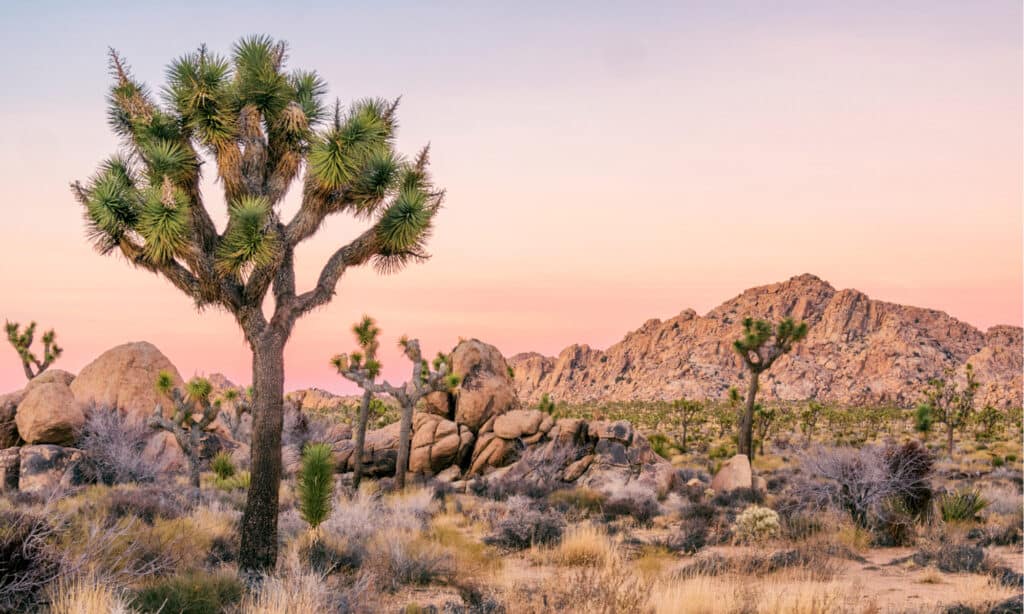
Joshua trees are a common sight around Lake Mead.
©Dennis Silvas/Shutterstock.com
The diverse assortment of plant and animal life near Lake Mead is one of its biggest attractions. Visitors can see everything from cacti and scorpions to trout and bald eagles. There is something for everyone to enjoy in this unique corner of the world.
Unlike many lakes and other large bodies of water, Lake Mead is not a natural lake. Lake Mead was created at the same time as the Hoover Dam. Initially, the lake was established so that it could provide a source of water for the region. Lake Mead was formed when the water flow from the Colorado River was slowed down.
The photo featured at the top of this post is © CrackerClips Stock Media/Shutterstock.com
Thank you for reading! Have some feedback for us? Contact the AZ Animals editorial team.






